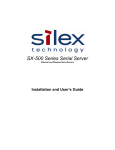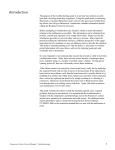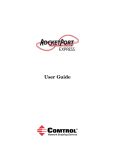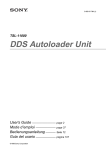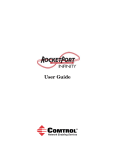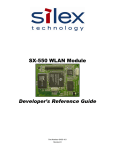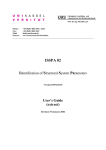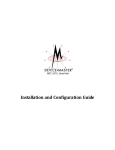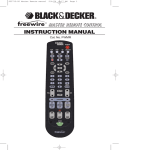Download DeviceMaster FreeWire Installation and User Guide
Transcript
Installation and User Guide Trademarks and Notices Notice Comtrol Corporation. SPECIFICALLY DISCLAIMS THE IMPLIED WARRANTIES OF MERCHANTABILITY AND FITNESS OF THIS PRODUCT FOR A PARTICULAR PURPOSE. Comtrol Corporation shall not be liable for any errors contained in this manual or for any damages resulting from loss of use, data, profits, or any incidental or consequential damages arising from the use of Comtrol Corporation products or services. The information contained in this documentation is subject to change without notice. Trademarks Comtrol is a trademark of Comtrol Corporation. Windows is a registered trademark of Microsoft Corporation. Ethernet is a trademark of Xerox Corporation. Other product names mentioned herein may be trademarks and/or registered trademarks of their respective owners. First Edition, August 21, 2008 Copyright © 2008. Comtrol Corporation. All Rights Reserved. Comtrol Corporation makes no representations or warranties with regard to the contents of this document or to the suitability of the Comtrol product for any particular purpose. This publication is subject to change without notice. Some software or features may not be available at the time of publication. Contact your reseller for current product information. Document Number: 2000412 Rev. A Table of Contents Product Overview .................................................................................................................5 DeviceMaster FreeWire Requirements .................................................................................................... 5 Installation Overview ................................................................................................................................... 5 Hardware Installation...........................................................................................................7 Device Descriptions ...................................................................................................................................... 7 Installing the DeviceMaster FreeWire Hardware.................................................................................. 7 LED Indicators .............................................................................................................................................. 9 Reset Button Functions .............................................................................................................................. 9 Factory Default Settings ........................................................................................................................... 10 Port Parameters .......................................................................................................................................... 11 Configuration and Management.......................................................................................13 Configuration Options................................................................................................................................ 13 Using the DeviceMaster FreeWire Management Utility .................................................................... 14 Installing the DeviceMaster FreeWire Management Utility ................................................................. 14 Configuring the DeviceMaster FreeWire ................................................................................................ 14 Using the Web Browser Interface ............................................................................................................ 18 Using the Command Console .................................................................................................................... 21 Telnet Connection..................................................................................................................................... 21 Serial Connection ..................................................................................................................................... 21 Installing and Configuring the COM Port Redirector ................................................23 Installing the COM Port Redirector........................................................................................................ 23 Changing the Serial Settings ................................................................................................................... 27 Accessing the COM Port Redirector ....................................................................................................... 27 Removing the COM Port Redirector ....................................................................................................... 27 Connecting the Serial Device ............................................................................................29 Serial Port Signals....................................................................................................................................... 29 DB9 Loopback Plugs ................................................................................................................................... 29 DB9 Null-Modem Cables............................................................................................................................. 30 DB9 Straight-Through Cables .................................................................................................................. 30 TCP Port Connections ................................................................................................................................ 31 Verifying the Installation ...................................................................................................33 Troubleshooting ..................................................................................................................35 Introduction ................................................................................................................................................. 35 Troubleshooting Installation Problems ................................................................................................ 35 Troubleshooting Network Configuration Problems ........................................................................... 35 Troubleshooting Windows Problems ..................................................................................................... 36 Troubleshooting Wireless Configuration Problems ........................................................................... 36 Where to Get Help ...................................................................................................................................... 37 Table of Contents DeviceMaster FreeWire Installation and User Guide: 2000412 Rev. A - iii Table of Contents Safety and Regulatory Notices .........................................................................................39 Information for United States Users ...................................................................................................... 39 Declaration of Conformity (FCC) ........................................................................................................... 40 Information for Canadian Users (IC notice) ........................................................................................ 40 Information for European Users ............................................................................................................. 40 iv - DeviceMaster FreeWire Installation and User Guide: 2000412 Rev. A Table of Contents Product Overview The DeviceMaster FreeWire is a high-performance, standalone device designed to connect a wide range of serial devices (i.e., security devices, telecommunications equipment, modems, data display devices, industrial instrumentation, etc.) to an Ethernet network. The DeviceMaster FreeWire supports RS-232 serial interfaces at a variety of baud rates (data transmission speeds), automatically senses both 100baseTX Fast Ethernet and 10baseT Ethernet network connections, and the wireless capability allows connections to 802.11g wireless networks as well. The installation can be performed by the least-experienced users, while providing networking professionals with advanced features for configuration. For specification information see the web site: http://www.comtrol.com/products/ specifications/31300-7. DeviceMaster FreeWire Requirements To use the wireless DeviceMaster FreeWire, you need an 802.11g compatible wireless network consisting of either of the following: • An 802.11b/g wireless-enabled PC connected directly to the DeviceMaster FreeWire (Ad-Hoc or Peer-to-Peer mode). • An 802.11b/g wireless access point that allows wireless and wired Ethernetenabled computers to connect to the serial server. To configure the wireless DeviceMaster FreeWire, you will need the following information from your wireless network administrator: • Wireless mode used (Infrastructure or Ad-Hoc) • The SSID (service set identifier) for your wireless network. • The Radio Frequency Channel of the wireless network. • If you are using TCP/IP (recommended for Windows® networks) and are not connected to a DHCP (Dynamic Host Configuration Protocol) server (for obtaining an IP Address automatically), you will need a unique IP Address for the DeviceMaster FreeWire (for example: 192.168.1.14). If the DeviceMaster FreeWire is not on the same IP subnet as the computers you are using, you will also need a subnet mask and a router (default gateway) address. • Wireless Security Settings (WEP keys, 802.1x settings, etc.) Installation Overview The DeviceMaster FreeWire installation follows these steps: 1. Install the hardware (Hardware Installation on Page 7). 2. Configure the DeviceMaster FreeWire using one of these methods: • DeviceMaster FreeWire Management Utility • Web page • Console port Refer to Configuration and Management on Page 13 for configuration procedures. DeviceMaster FreeWire Installation and User Guide: 2000412 Rev. A Product Overview - 5 Installation Overview 3. For COM port support, install and configure the port redirector. See Installing and Configuring the COM Port Redirector on Page 23 to locate and install the redirector. 4. Connect your serial device to the DeviceMaster FreeWire. 6 - Product Overview DeviceMaster FreeWire Installation and User Guide: 2000412 Rev. A Hardware Installation This section discusses the following hardware related topics in addition to the hardware installation procedure: • Device Descriptions (below) • LED Indicators on Page 9 • Reset Button Functions on Page 9 • Factory Default Settings on Page 10 • Port Parameters on Page 11 Device Descriptions The DeviceMaster FreeWire includes the components that are discussed in the following subsections: • Power connector – The power supply cable plugs into this connector. • LED status indicators (Power, 10, and 100) – Indicate the operational states of the DeviceMaster FreeWire. See LED Indicators on Page 9 for detailed LED status light descriptions. • Reset button – Pressing the Reset button for less than five seconds prints a test page (if the device is connected to a serial printer). Pressing and holding the Reset button for more than five seconds resets the DeviceMaster FreeWire to factory default settings (Reset Button Functions on Page 9). • 10/100 – The RJ45 Ethernet port is used for connecting the DeviceMaster FreeWire to an Ethernet card, hub, router, or other wired access point for network access. • RS232 – The DB9 serial port can be configured to connect the DeviceMaster FreeWire to a serial device that uses the RS-232 serial interface. Installing the DeviceMaster FreeWire Hardware The DeviceMaster FreeWire can be wall mounted, set on the desktop, or mounted using the optional DIN rail kit available from Comtrol Corporation. 1. Write down the 12-digit MAC (Media Access Code) address printed on the label located on the bottom of the DeviceMaster FreeWire (for example: 00 C0 4E 27 00 00). You may need this number in order to configure the DeviceMaster FreeWire. 2. Plug the DeviceMaster FreeWire power supply adapter into a suitable AC receptacle, and then plug the power supply cable into the DeviceMaster FreeWire. The DeviceMaster FreeWire will run through a sequence of powerup diagnostics for a few seconds. DeviceMaster FreeWire Installation and User Guide: 2000412 Rev. A Hardware Installation - 7 Installing the DeviceMaster FreeWire Hardware • If the DeviceMaster FreeWire is operating properly, the LEDs will blink momentarily and then go out, the yellow (10) and green (100) LEDs will illuminate if the network is active, and the orange (Power) LED will illuminate, indicating the device is receiving power. • The unit powers up in the Normal mode, which provides for connection from the network to the device connected to the serial port of the DeviceMaster FreeWire. • If the Power LED blinks continuously in a regular pattern, a problem exists. If this is the case, try powering the unit off and then on again. If the problem persists, refer to Troubleshooting on Page 35. See LED Indicators on Page 9 for detailed information about the LEDs. 3. Connect the DeviceMaster FreeWire to your network through a switch or hub using a category 5 (CAT5) Ethernet cable. The DeviceMaster FreeWire IP address must be configured before a network connection is available. • The DeviceMaster FreeWire is configured with a static (fixed) IP address of 192.168.250.250 (see your system administrator for assistance). In most cases, a fixed IP address is preferred because a DHCP server may not always assign the same IP address to the DeviceMaster FreeWire when the DeviceMaster FreeWire is powered on. • If you want to use DHCP, you must configure the DeviceMaster FreeWire for DHCP during the network configuration process. Note: If a wired connection is established to the unit, the wireless link will be disabled. The IP address must be within a valid range, unique to your network, and in the same subnet as your PC. 4. Go to Configuration and Management on Page 13 for DeviceMaster FreeWire configuration procedures. 8 - Hardware Installation DeviceMaster FreeWire Installation and User Guide: 2000412 Rev. A LED Indicators LED Indicators The DeviceMaster FreeWire provides three multifunction LED (Light Emitting Diode) indicators (yellow, green, and orange) for easy monitoring. The following table defines the function of each LED. Function POWER (Orange) State Status ON The DeviceMaster FreeWire is receiving power OFF The DeviceMaster FreeWire is not receiving power Blinking The DeviceMaster FreeWire power supply is malfunctioning Yellow OFF Green OFF Yellow ON Green OFF Yellow Blinking Green OFF NETWORK STATUS Yellow OFF (Yellow/Green) Green ON Yellow OFF Green Blinking Yellow ON Green ON Yellow Blinking Green Blinking No network activity 10baseT network active 10baseT network data received 100baseTX network active 100baseTX network data received Wireless network active Wireless network data received Reset Button Functions Action Depress for less than 5 seconds Result Generates configuration data that can be viewed using a terminal emulator (e.g., Windows Hyper Terminal) or other serial device that can display ASCII characters, or it will initiate a test page if the DeviceMaster FreeWire is connected to a serial printer. Depress for more Resets the DeviceMaster FreeWire’s configuration to factory defaults (cold reset). The unit will automatically re-initialize than 5 seconds after updating the configuration memory. Depress for 3 seconds during power up Places the device into console configuration mode, which can be used to configure the device via the DeviceMaster FreeWire’s serial port. DeviceMaster FreeWire Installation and User Guide: 2000412 Rev. A Hardware Installation - 9 Factory Default Settings Factory Default Settings The DeviceMaster FreeWire is shipped with a default configuration that works with the most common serial-to-Ethernet and wireless connections. The default settings can be changed to suit specific installation requirements via the DeviceMaster FreeWire Management Utility, embedded Web server, or via a Telnet connection to the DeviceMaster FreeWire internal console. The factory default settings can be easily restored at any time by performing a cold reset (press and hold the Reset button on the device for more than five seconds). The following table lists the DeviceMaster FreeWire default settings. Parameter Description Character bits per character 8 Flow flow control None Parity parity None Baud rate bits per second 115,200 Stop stop bits per character 1 Mode line mode (serial port protocol) 232 ECABLE E-Cable mode (for TCP connections) Disable ECADDR E-Cable destination IP address (set by user) ECONN E-Cable connection attempt time 20 seconds ECPORT E-Cable destination IP port number 9100 Web browser password (not case-sensitive) 10 - Hardware Installation Settings ACCESS 192.168.250.250 255.255.0.0 0.0.0.0 Network settings IP address Subnet mask Default Gateway Protocols DHCP, static addressing, arp, rasp, and BootP protocols DeviceMaster FreeWire Installation and User Guide: 2000412 Rev. A Port Parameters Port Parameters Parameter Description CHARACTER bits per character Settings 7, 8 (default) FLOW flow control NONE (default), Xon/Xoff, CTS/RTS PARITY parity NONE (default), EVEN, ODD, MARK, or SPACE SPEED baud rate (bits per second) 300, 600, 1200, 2400, 3600, 4800, 7200, 9600, 14400, 19200, 38400, 57600, 76800, 115200 (default), 230400, 460800 STOP stop bits per character 1 (default), 2 MODE line mode (serial port 232 (default), Disabled protocol) ECABLE E-Cable mode (for TCP connections) Enable, Disable (default) ECADDR E-Cable destination IP address (set by user) ECONN E-Cable connection attempt time 20 seconds ECPORT E-Cable destination IP port number 9100 (default), or set by user Note: The default IP address is 192.168.250.250. DeviceMaster FreeWire Installation and User Guide: 2000412 Rev. A Hardware Installation - 11 Port Parameters This page was intentionally left blank. 12 - Hardware Installation DeviceMaster FreeWire Installation and User Guide: 2000412 Rev. A Configuration and Management Configuration Options After the hardware installation has been successfully completed, the DeviceMaster FreeWire is ready for configuration. There are three configuration and management methods from which to chose: • DeviceMaster FreeWire Management Utility (Page 14) - • Embedded web server pages (Page 18) - • User-friendly interface makes configuration fast and easy. Check DeviceMaster FreeWire status information. Print a configuration sheet. Reset the DeviceMaster FreeWire. Save or restore a configuration for the DeviceMaster FreeWire. Configure multiple DeviceMaster FreeWires at the same time. Change options such as the DeviceMaster FreeWire access protocol, timeout values, and status icons. Allows you to update the firmware. Allow you to configure the DeviceMaster FreeWire with a standard web browser (for example, Firefox or Internet Explorer). No additional software is needed on the system. Can be used on any system that supports web browser capabilities. Type the IP address into your web browser address bar to connect. DeviceMaster FreeWire internal configuration console, which can be accessed via a Telnet connection or directly through the DeviceMaster FreeWire serial port (Page 21). The Command Console is a command-line-oriented console: - Contains some advanced features not available through the Web Browser Interface. Can be accessed via Telnet or via a direct connection to the DeviceMaster FreeWire’s serial port. Requires a DB9 RS-232 null-modem cable for serial connection. Type HELP for a list of console commands. DeviceMaster FreeWire Installation and User Guide: 2000412 Rev. A Configuration and Management - 13 Using the DeviceMaster FreeWire Management Utility Using the DeviceMaster FreeWire Management Utility Use the following subsections to install the DeviceMaster FreeWire Management Utility and configure the DeviceMaster FreeWire. Refer to the help system for information about using the DeviceMaster FreeWire Management Utility. Installing the DeviceMaster FreeWire Management Utility You can install the DeviceMaster FreeWire Management Utility from the Software and Documentation CD shipped with your product or download it from the web site: http://www.comtrol.com/support/download.asp?partnumber=1800353. Use the following procedure to install the DeviceMaster FreeWire Management Utility. 1. Unzip the DeviceMaster FreeWire Management Utility, execute the setup.exe file, and click Next at the Welcome window. 2. Click I accept the terms of the license agreement and Next to continue the installation. 3. Click Next at the Choose Destination Location window. 4. Click Install to install the DeviceMaster FreeWire Management Utility. 5. Click Finish. Configuring the DeviceMaster FreeWire Use the following procedure to configure the DeviceMaster FreeWire. Note: To configure the DeviceMaster FreeWire, the IP address must also be valid for the network to which it is attached. The network segment must be 192.168.250.x to communicate to the DeviceMaster FreeWire default IP address of 192.168.250.250. 1. From the Start Program group, click Comtrol/DeviceMaster FreeWire/ Management Utility. 2. Click Next at the Welcome window. 3. Press Next to use the default settings or enter a name or change the discovery method. The name or discovery method can be changed later if so desired. The DeviceMaster FreeWire Management Utility takes a few moments to locate the DeviceMaster FreeWire. 4. Right-click the DeviceMaster FreeWire in the right pane and click Configuration. Note: Optionally, you can use the Configuration Wizard to configure the IP addresses and serial port parameters for the DeviceMaster FreeWire. After using the wizard, you will need to configure the wireless parameters. 14 - Configuration and Management DeviceMaster FreeWire Installation and User Guide: 2000412 Rev. A Configuring the DeviceMaster FreeWire 5. Select the appropriate IP address type and change the IP address to reflect your network requirements. If necessary, see the network administrator for a static IP address. Optionally, configure a telnet/http password or click Advanced TCP/IP to change the TCP Connection Timeout, Unsolicited ARP, or DNS settings. 6. To configure output port settings, click the Output Port tab and click the appropriate selections for your environment. DeviceMaster FreeWire Installation and User Guide: 2000412 Rev. A Configuration and Management - 15 Configuring the DeviceMaster FreeWire 7. Click the Wireless tab. a. Select the appropriate Wireless Mode. b. Enter the SSID for your wireless network. c. If you selected Ad Hoc, select the corresponding channel to match your network. d. If necessary, change the Data Rate and Access Point Density values to meet your needs. e. If necessary, click Wireless Security to set up security settings to match your wireless network. 8. Click the SNMP tab if you need to change the default values. 16 - Configuration and Management DeviceMaster FreeWire Installation and User Guide: 2000412 Rev. A Configuring the DeviceMaster FreeWire 9. Click the Protocol tab if you want to disable an available protocol. 10. Click the SNMP Traps tab for set up. 11. Click Ok when you are done with the configuration changes and then click Ok to the Save changes and reset device message. It takes several moments for the DeviceMaster FreeWire to reboot with the updated configuration parameters. 12. To confirm wireless operation: a. Close the DeviceMaster FreeWire Management Utility and disconnect the Ethernet cable. b. Re-open the DeviceMaster FreeWire Management Utility and verify that the DeviceMaster FreeWire appears in the view. Note: It takes approximately 7 seconds before the connection is operational. If the DeviceMaster FreeWire does not appear in the view, see Troubleshooting on Page 35. 13. To use the serial port as a COM port, go to Installing and Configuring the COM Port Redirector on Page 23 to install and configure the COM port redirector. After optionally installing the COM port redirector, you are ready to connect the serial device to the DeviceMaster FreeWire. Refer to Connecting the Serial Device on Page 29 for serial port pinout information and Verifying the Installation on Page 33 to complete the installation. DeviceMaster FreeWire Installation and User Guide: 2000412 Rev. A Configuration and Management - 17 Using the Web Browser Interface Using the Web Browser Interface Optionally, you can configure the DeviceMaster FreeWire using a standard web browser to access the DeviceMaster FreeWire embedded web server pages, which contain the DeviceMaster FreeWire configuration options. No additional software is required. Note: To configure the DeviceMaster FreeWire, the IP address must also be valid for the network to which it is attached. The network segment must be 192.168.250.x to communicate to the DeviceMaster FreeWire default IP address of 192.168.250.250. 1. Verify that your PC is connected and has access to the network. 2. If you have not done so, connect an available Ethernet cable from your network hub to the DeviceMaster FreeWire and verify that the DeviceMaster FreeWire is powered on. To operate on an 802.11b/g network, you must set up the same configuration as the wireless network you want the DeviceMaster FreeWire to communicate on. All nodes of a wireless network need to have the same settings in order to communicate with each other. • Wireless mode (ad-hoc or infrastructure) • SSID channel • Data rate • Security settings (WEP keys, 802.1x settings, etc.) 3. From the host computer, open a standard web browser, enter the IP address of the DeviceMaster FreeWire into the address bar of the web browser, and then press Enter. The Web Browser Utility screen displays. 4. Click the Login menu selection (left), enter the password (default is ACCESS), and then click Submit. 18 - Configuration and Management DeviceMaster FreeWire Installation and User Guide: 2000412 Rev. A Using the Web Browser Interface 5. Use the web page to configure the settings of the DeviceMaster FreeWire. The menu selections are displayed on the left side of the screen, and the individual settings are located at the top of the screen. At a minimum, you need to configure the following pages: • I/O Port - if you are using the serial port in socket mode. • TCP/IP- to configure the DeviceMaster FreeWire IP address for your network. DeviceMaster FreeWire Installation and User Guide: 2000412 Rev. A Configuration and Management - 19 Using the Web Browser Interface • Wireless - to configure the wireless settings that match your network. • Admin - you may want to configure network access password and an update password, which prevents unauthorized configuration changes. 6. To confirm wireless operation: a. Close the web browser and disconnect the Ethernet cable. a. Re-open the web browser, enter the IP address, and verify that DeviceMaster FreeWire web page loads. Note: It takes approximately 7 seconds before the connection is operational. If the web page does not load, see Troubleshooting on Page 35. 7. To use the serial port as a COM port, go to Installing and Configuring the COM Port Redirector on Page 23 to install and configure the COM port redirector. After optionally installing the COM port redirector, you are ready to connect the serial device to the DeviceMaster FreeWire. Refer to Connecting the Serial Device on Page 29 for serial port pinout information and Verifying the Installation on Page 33 to complete the installation. 20 - Configuration and Management DeviceMaster FreeWire Installation and User Guide: 2000412 Rev. A Using the Command Console Using the Command Console You can use a telnet or serial connection to configure the DeviceMaster FreeWire using the Command Console. Telnet Connection Use this procedure to access the Command Console through telnet. Note: To configure the DeviceMaster FreeWire, the IP address must also be valid for the network to which it is attached. The network segment must be 192.168.250.x to communicate to the DeviceMaster FreeWire default IP address of 192.168.250.250. 1. Ensure the DeviceMaster FreeWire is connected via an Ethernet cable to the host computer. 2. From the Windows Start menu, click Run, and then type the following command (where x.x.x.x. is the IP address of the DeviceMaster FreeWire). The system will use the default port 23. telnet X.X.X.X 3. After a connection is established, press Return or Enter to get the # prompt, enter the password ACCESS (it will not “echo” on your screen), and type anything in response to the Enter Username> prompt. When the Local> prompt appears, you are ready to enter commands. For a list of commands, type help at the command prompt. 4. After configuring the DeviceMaster FreeWire, confirm wireless operation: a. Close the Command Console, and disconnect the Ethernet cable. b. Re-open a telnet session, enter the IP address, and verify that a DeviceMaster FreeWire telnet session opens. Note: It takes approximately 7 seconds before the connection is operational. If the telnet session does not start, see Troubleshooting on Page 35. 5. To use the serial port as a COM port, go to Installing and Configuring the COM Port Redirector on Page 23 to install and configure the COM port redirector. After optionally installing the COM port redirector, you are ready to connect the serial device to the DeviceMaster FreeWire. Refer to Connecting the Serial Device on Page 29 for serial port pinout information and Verifying the Installation on Page 33 to complete the installation. Serial Connection The DeviceMaster FreeWire Command Console can be accessed via a direct connection to the DeviceMaster FreeWire serial port using a COM port emulator and a null-modem serial cable. 1. Attach one end of a null-modem serial cable to the DB9 serial port of the DeviceMaster FreeWire, and the other end of the cable to the COM port on your computer. 2. Press and hold the DeviceMaster FreeWire Reset button for at least three seconds while powering up the device. When the DeviceMaster FreeWire has finished initializing, the internal configuration console will be ready to accept commands. 3. Start a terminal emulation program (e.g., Windows Hyper Terminal), making sure you are connecting with the relevant COM port. Note: You can use Test Terminal (WCOM2), which is available on the CD. You can also download the latest version from the web site: http:// www.comtrol.com/support/download.asp?partnumber=1800355. DeviceMaster FreeWire Installation and User Guide: 2000412 Rev. A Configuration and Management - 21 Serial Connection 4. Use the following settings for the connection: • Bits Per Second: 115200 • Data Bits: 8 • Parity: None • Stop Bits: 1 • Flow Control: None 5. Once connected, press Enter to continue. The Local> prompt appears indicating that the system is ready to accept commands. For a list of commands, type help at the command prompt. 6. After configuring the DeviceMaster FreeWire, confirm wireless operation: a. Close the Command Console, and disconnect the Ethernet cable. b. Re-open a telnet session, enter the IP address, and verify that a DeviceMaster FreeWire telnet session opens. Note: It takes approximately 7 seconds before the connection is operational. If the telnet session does not start, see Troubleshooting on Page 35. 7. To use the serial port as a COM port, go to Installing and Configuring the COM Port Redirector on Page 23 to install and configure the COM port redirector. After optionally installing the COM port redirector, you are ready to connect the serial device to the DeviceMaster FreeWire. Refer to Connecting the Serial Device on Page 29 for serial port pinout information and Verifying the Installation on Page 33 to complete the installation. 22 - Configuration and Management DeviceMaster FreeWire Installation and User Guide: 2000412 Rev. A Installing and Configuring the COM Port Redirector Use this section to install and configure the COM port redirector for the following operating systems: • Windows 2000 • Windows XP • Windows Server 2003 • Windows Vista Note: The DeviceMaster FreeWire COM Port Redirector is a licensed copy that contains a permanent key. Installing the COM Port Redirector You can install the DeviceMaster FreeWire COM port redirector from the Software and Documentation CD shipped with your product or download it from the web site: http://www.comtrol.com/support/download.asp?partnumber=1800352. Use the following procedure to install the DeviceMaster FreeWire COM port redirector. 1. Execute the COM port redirector assembly and click Next at the Welcome window. 2. Click I accept the terms of the license agreement and Next to continue the installation. 3. Click Next at the Choose Destination Location window. DeviceMaster FreeWire Installation and User Guide: 2000412 Rev. A Installing and Configuring the COM Port Redirector - 23 Installing the COM Port Redirector 4. Click Next to continue the installation. Note: Click Disk Cost if you want to see how much space is available on your system. 5. Click Next to continue the installation. 6. Click Finish. Optionally, review the readme.txt file and close it. 7. Select the COM port number that you want to associate with the DeviceMaster FreeWire serial port and click Ok. Note: Only available COM ports are displayed. 24 - Installing and Configuring the COM Port Redirector DeviceMaster FreeWire Installation and User Guide: 2000412 Rev. A Installing the COM Port Redirector 8. Click Configuration Wizard. 9. Enter the DeviceMaster FreeWire IP address and Port Number and then click Start. The default port numbers for the DeviceMaster FreeWire Port Number are: • Port 9100 - Raw TCP connection • Port 9200 - Telnet Protocol DeviceMaster FreeWire Installation and User Guide: 2000412 Rev. A Installing and Configuring the COM Port Redirector - 25 Installing the COM Port Redirector 10. Review the DeviceMaster FreeWire status to verify that the DeviceMaster FreeWire connection has been successfully completed and click Use Settings to close the wizard. Refer to help system if the connection fails for troubleshooting information. Click Stop to disrupt the verification process, Copy to place a copy of the status window contents on the clipboard, and Cancel to return to the previous screen. 11. After installing the COM port redirector, you are ready to connect the serial device to the DeviceMaster FreeWire. Refer to Connecting the Serial Device on Page 29 for serial port pinout information and Verifying the Installation on Page 33 to complete the installation. 26 - Installing and Configuring the COM Port Redirector DeviceMaster FreeWire Installation and User Guide: 2000412 Rev. A Changing the Serial Settings Changing the Serial Settings In order to establish communication between the DeviceMaster FreeWire and a serial device, the serial settings for both devices must match. The serial settings can be changed using the DeviceMaster FreeWire Management Utility, web browser interface, or the DeviceMaster FreeWire internal configuration console. For information refer to Configuration and Management on Page 13. When using the COM port redirector with Telnet, all serial port settings will be configured through the PC application controlling the COM port. See Factory Default Settings on Page 10 for a list of factory default settings. Accessing the COM Port Redirector After initial installation of the COM port redirector, access the DeviceMaster FreeWire Control Panel for the COM port redirector through the Start/All Programs/Comtrol/FreeWire/Control Panel selection. Use the help system for information about using the port redirector. Removing the COM Port Redirector Use the Add/Remove Programs Control Panel to remove the DeviceMaster FreeWire port redirector. DeviceMaster FreeWire Installation and User Guide: 2000412 Rev. A Installing and Configuring the COM Port Redirector - 27 Removing the COM Port Redirector This page was intentionally left blank. 28 - Installing and Configuring the COM Port Redirector DeviceMaster FreeWire Installation and User Guide: 2000412 Rev. A Connecting the Serial Device Connect the DeviceMaster FreeWire to your serial device using a standard RS-232 DB9 serial cable. You can build your own null-modem or straight-through DB9 serial cables using the following subsections. Serial Port Signals The following table provide serial port pinouts for the DeviceMaster FreeWire. DB9 Connector Pinouts Pin 1 2 3 4 5 6 7 8 9 RS-232 DCD RxD TxD DTR GND DSR RTS CTS RI (Ring) or +5 VDC power input (selectable via 3-pin jumper) RS-232 GND DTR TxD RxD CD Pin 1 RI CTS RTS DSR Pin 6 DB9 Male DB9 Loopback Plugs Loopback connectors are DB9 female serial port plugs, with pins wired together as shown, that are used in conjunction with application software (Test Terminal) to test serial ports. The DeviceMaster FreeWire is shipped with a a single loopback plug (RS-232). Note: You can use Test Terminal to test the serial ports. You can use the Support page on the CD shipped with the DeviceMaster FreeWire. Wire the following pins together to build additional plugs or replace a missing RS-232 loopback plug: • Pins 1 to 4 to 6 • Pins 2 to 3 • Pins 7 to 8 to 9 DeviceMaster FreeWire Installation and User Guide: 2000412 Rev. A Pin 1 Pin 6 Pin 5 Pin 9 Connecting the Serial Device - 29 DB9 Null-Modem Cables DB9 Null-Modem Cables Use the following figure if you need to build an RS-232 null-modem cable. A nullmodem cable is required for connecting DTE devices. Female DeviceMaster DB9 Signal Pins TxD 3 RxD 2 RTS 7 CTS 8 DSR 6 1 DCD DTR 4 GND 5 DB9 DB25 RJ45 Pins Pins Pins Signal RxD 2 3 5 TxD 3 2 4 CTS 8 5 8 RTS 7 4 1 DTR 4 20 2 DCD 1 8 6 DSR 6 6 7 GND 5 7 3 Note: You may want to purchase or build a straight-through cable and purchase a null-modem adapter. For example, a null-modem cable can be used to connect COM2 of one PC to COM2 of another PC. DB9 Straight-Through Cables Use the following figure if you need to build an RS-232 straight-through cable. Straight-through cables are used to connect modems and other DCE devices. For example, a straight-through cable can be used to connect COM2 of one PC to COM2 to a modem. Female DeviceMaster DB9 30 - Connecting the Serial Device Signal Pins 1 DCD 2 RxD 3 TxD 4 DTR 5 GND 6 DSR 7 RTS 8 CTS RI 9 DB9 RJ45 DB25 Pins Pins Pins 6 1 8 5 2 3 4 3 2 2 4 20 3 5 7 7 6 6 1 7 4 8 8 5 N/A 22 9 Signal DCD RxD TxD DTR GND DSR RTS CTS RI DeviceMaster FreeWire Installation and User Guide: 2000412 Rev. A TCP Port Connections TCP Port Connections The DeviceMaster FreeWire supports port connections over TCP/IP using raw TCP ports only. The TCP ports are allocated as follows. Port Destination Device 3001 RS-232 9100 RS-232 9200 RFC 2217 You should set the port to port forwarding in routers and firewalls. DeviceMaster FreeWire Installation and User Guide: 2000412 Rev. A Connecting the Serial Device - 31 TCP Port Connections This page was intentionally left blank. 32 - Connecting the Serial Device DeviceMaster FreeWire Installation and User Guide: 2000412 Rev. A Verifying the Installation There are several ways to verify that the serial port is functioning. This section discusses how to test a serial device able to display ASCII characters. Refer to the DeviceMaster FreeWire Software and Documentation CD for procedures of how to use Test Terminal and the loopback plug to verify that the serial port is functioning. Use the following procedure to verify that the DeviceMaster FreeWire and the serial device are working correctly. 1. Verify that both the DeviceMaster FreeWire and the connected serial device are powered on and ready, and that a serial cable is properly connected between the DeviceMaster FreeWire and serial device (i.e., transmit signal output from the DeviceMaster FreeWire going to the receive signal input on the serial device, ground leads connected together, etc.). Note: Before attempting to use the DeviceMaster FreeWire, you must verify the connection between the DeviceMaster FreeWire and the connected serial device. If this connection is not working, you will not be able to send and/or receive data from the connected serial device. 2. Verify that the DeviceMaster FreeWire port settings (i.e., baud rate, flow control, character bit size, parity, etc.) exactly match the settings of the connected serial device port. 3. If the serial device connected to the DeviceMaster FreeWire is able to display or print ASCII characters (such as a terminal emulator or serial printer), then communication between the devices can be verified by pressing the Reset button on the DeviceMaster FreeWire for about one second (but less than five seconds), which initiates the output of configuration data from the DeviceMaster FreeWire to the connected serial device. • If communication has been successfully established between the two devices, the serial device should be able to display or print the DeviceMaster FreeWire’s configuration data. • If no data is displayed or printed, verify that both devices are powered ON, are properly connected using a suitable serial cable, and are using compatible serial port parameters. The two most common serial communication problems are due to the either the cabling and/or mismatched serial port parameters. Note: If the DeviceMaster FreeWire is connected to a serial device that cannot display or print ASCII characters, then it is recommended that another serial device capable of displaying or printing ASCII characters be temporarily connected to the DeviceMaster FreeWire in order to verify the serial connection. After successful communication is verified using the temporary serial device, reconnect the original serial device, making sure that the original serial device is configured with serial port parameters that match the tested connection. If you are having installation problems, see Troubleshooting on Page 35 or the Software and Documentation CD for assistance. DeviceMaster FreeWire Installation and User Guide: 2000412 Rev. A Verifying the Installation - 33 This page was intentionally left blank. 34 - Verifying the Installation DeviceMaster FreeWire Installation and User Guide: 2000412 Rev. A Troubleshooting Introduction This section describes procedures for troubleshooting problems you may encounter with the DeviceMaster FreeWire, and is divided into the following sections: • Troubleshooting Installation Problems • Troubleshooting Network Configuration Problems on Page 35 • Troubleshooting Windows Problems on Page 36 • Troubleshooting Wireless Configuration Problems on Page 36 If your problem is not resolved using the troubleshooting sections, you can use Where to Get Help on Page 37 for additional help. Troubleshooting Installation Problems If you cannot access the connected serial device via the DeviceMaster FreeWire, first check the network connection and cabling. • Check the physical cabling to ensure all cables are plugged in (Ethernet and DB-9 serial cable). • If the appropriate LEDs are not illuminated, then there is probably a bad 10baseT or 100baseTX cable, or the hub port is bad. If possible, try a different cable and hub port, or try connecting a different device to the cable. • Verify that you using the correct values for both IP Address and Port Number. A common mistake is to assume the TCP port number is the “device number” on the server. • If you are using a hub, verify that the hub port is operating correctly by trying the DeviceMaster FreeWire on a different port. Troubleshooting Network Configuration Problems The following information may help you diagnose network configuration problems. • If you are using TCP/IP, make sure that your computer and the DeviceMaster FreeWire are on the same IP segment or can reach each other with a PING command from the host. The IP address you assign to the DeviceMaster FreeWire must be on the same logical network as your host computers (e.g., if your computer has an IP address of 192.189.207.3, the DeviceMaster FreeWire should have an IP address of 192.189.207.x, where x is an integer between 1 and 254), or you must properly configure your router address to work with the DeviceMaster FreeWire. • If your DeviceMaster FreeWire is set to Auto or DHCP for obtaining an IP address, it is possible that the DeviceMaster FreeWire IP address can change. Either configure your DHCP server to give the DeviceMaster FreeWire a permanent lease, or configure the DeviceMaster FreeWire to be on a STATIC IP address outside the scope of the DHCP addresses. DeviceMaster FreeWire Installation and User Guide: 2000412 Rev. A Troubleshooting - 35 Troubleshooting Windows Problems • The problem may be the result of mismatched or duplicate IP addresses. Verify that the IP address is correctly loaded into the DeviceMaster FreeWire (via the displayed or printed configuration information or through the remote console), and make sure that no other nodes on the network have this address (duplicate addresses are the biggest cause of TCP/IP connectivity problems). If the IP address is not correct, then check whether the loading procedure was properly executed. • Verify that the host computer and the DeviceMaster FreeWire are either on the same subnet (for example, if the DeviceMaster FreeWire has a subnet mask of 255.255.255.0, the host must have the same subnet mask) or that the router is properly configured to pass data between the two devices. • If the wrong IP address is loaded, check your network for file servers that have DHCP, BOOTP, or rarp enabled, and make sure that these file servers are not set up to load IP addresses into the DeviceMaster FreeWire. Troubleshooting Windows Problems • If you are having trouble accessing the connected serial device through Windows, ensure you can ping the DeviceMaster FreeWire using the DOS command PING ipaddress, where ipaddress is the IP address of the DeviceMaster FreeWire. If you cannot ping the DeviceMaster FreeWire, you will not be able to access the serial device. • If the DeviceMaster FreeWire COM port redirector reports an error, verify that the correct serial/IP COM port is being used when the application runs. Verify that your application’s COM port settings have been changed to use the serial/IP COM ports. Troubleshooting Wireless Configuration Problems 36 - Troubleshooting • Verify that your PC’s wireless adapter and/or access point is configured properly – note the settings, paying special attention to the wireless mode, SSID or network name, WEP or security, and IP address settings so you can configure your DeviceMaster FreeWire to the same wireless settings. • Make sure you have a good wireless signal from your PC and from the DeviceMaster FreeWire, that the DeviceMaster FreeWire is within range (90 meters or 300 feet), and that it is away from metal objects and other devices that generate radio signals (like Bluetooth devices, cordless phones, and microwave ovens). • Make sure your computer is set to infrastructure mode if you are connecting through an access point, or ad-hoc (802.11) if you are connecting to the DeviceMaster FreeWire without an access point. See the documentation for your wireless adapter for details. • If you want to use WEP encryption or password protection for your wireless network, and your wireless adapter or access point normally uses a password or passphrase instead of WEP, it should allow you to enter 0x followed by a 10digit key (for 40-bit or 64-bit WEP) or 26-digit key (for 128-bit WEP) in hexadecimal format (0-9 or A-F). • If you are experiencing slow performance or are having intermittent problems connecting, try changing the RF channel of your wireless network. The RF channel can be changed via the web browser configuration utility for the DeviceMaster FreeWire. See your wireless adapter and/or access point documentation for more information. When changing the RF channel, it is recommended that you select a channel that is at least three channels lower or higher than any other wireless networks within range. DeviceMaster FreeWire Installation and User Guide: 2000412 Rev. A Where to Get Help Where to Get Help Comtrol Corporation offers several customer support options to assist you in the event you experience difficulties with the DeviceMaster FreeWire, including telephone support, repair services, and warranty. Your first point of contact for technical support is the Distributor or Dealer from whom you bought your product. They are familiar with your needs, and will generally be able to provide you with the fastest and most comprehensive support. If your Distributor or Dealer is unable to answer your questions or is for some reason not available, then contact Comtrol Corporation. Before contacting Technical Support, please refer to the troubleshooting suggestions or the web site in this manual to isolate any problems, and be sure to write down any error messages. Also, make sure that you have the serial number of the product (located on the product label on the back of the DeviceMaster FreeWire). Comtrol Contact Information Downloads http://www.comtrol.com/downloads Web site http://www.comtrol.com Forum http://formum.comtrol.com Phone (763) 494-4100 DeviceMaster FreeWire Installation and User Guide: 2000412 Rev. A Troubleshooting - 37 Where to Get Help This page was intentionally left blank. 38 - Troubleshooting DeviceMaster FreeWire Installation and User Guide: 2000412 Rev. A Safety and Regulatory Notices This section provides the following: • Information for United States Users • Declaration of Conformity (FCC) on Page 40 • Information for Canadian Users (IC notice) on Page 40 • Information for European Users on Page 40 Information for United States Users This equipment has been tested and found to comply within the limits for a Class B digital device pursuant to Part 15 of the FCC Rules. These limits are designed to provide reasonable protection against harmful interference in a residential installation. This equipment generates, uses, and can radiate radio frequency energy and, if not installed and used in accordance with the instructions, may cause harmful interference to radio communications. However, there is no guarantee that interference will not occur in a particular installation. If this equipment does cause harmful interference to radio and television reception, which can be determined by turning the equipment off and on, the user is encouraged to try to correct the interference by one or more of the following measures: • Reorient or relocate the receiving antenna. • Increase the separation between the equipment and receiver, Connect the equipment into an outlet on a circuit different from that to which the receiver is connected. • Consult the dealer or an experienced radio/TV technician for help. The user is cautioned that changes and modifications made to the equipment without the approval of manufacturer could void the user’s authority to operate this equipment. Operation is subject to the following two conditions: (1) This device may not cause harmful interference, and (2) this device must accept any interference received, including interference that may cause undesired operation. The radiated output power of the print server is far below the FCC radio frequency exposure limits. Nevertheless, print server shall be used in such a manner that the potential for human contact during normal operation is minimized. To satisfy RF exposure requirements, this device and its antenna(s) must operate with a separation distance of at least 20 centimeters from all persons and must not be co-located or operating in conjunction with any other antenna or transmitter. End-users must be provided with specific operating instructions for satisfying RF exposure compliance. DeviceMaster FreeWire Installation and User Guide: 2000412 Rev. A Safety and Regulatory Notices - 39 Declaration of Conformity (FCC) Declaration of Conformity (FCC) According to 47CFR, Part 2 and 15 for Class B Personal Computers and Peripherals; and/or CPU Boards and Power Supplies used with Class B Personal Computers: Comtrol Corporation 6655 Wedgwood Road Maple Grove, MN 55311 Declare under sole responsibility that the product identified herein, complies with 47CFR Part 2 and 15 of the FCC rules as a Class B digital device FOR HOME OR OFFICE USE. Each product marketed, is identical to the representative unit tested and found to be compliant with the standards. Records maintained continue to reflect the equipment being produced can be expected to be within the variation accepted, due to quantity production and testing on a statistical basis as required by 47CFR §2.909. Operation is subject to the following two conditions: (1) this device may not cause harmful interference, and (2) this device must accept any interference received, including interference that may cause undesired operation. Information for Canadian Users (IC notice) The term “IC” before the radio certification number only signifies that Industry of Canada technical specifications were met. Operation is subject to the following two conditions: (1) this device may not cause interference, and (2) this device must accept any interference, including interference that may cause undesired operation of the device. This Class B digital apparatus meets all requirements of the Canadian Interference-Causing Equipment Regulations. To prevent radio interference to the licensed service, this device is intended to be operated indoors and away from windows to provide maximum shielding. Equipment that is installed outdoors is subject to licensing. This device has been designed to operate with an antenna having a maximum gain of 2 dB. Antenna having a higher gain is strictly prohibited per regulations of Industry Canada. The required antenna impedance is 50 ohms. To reduce potential radio interference to other users, the antenna type and its gain should be so chosen than the equivalent isotropically radiated power (EIRP) is not more than the required for successful communication. Information for European Users The server and its built-in 802.11b, and 802.11g wireless technology is in compliance with the Class B Information Technology Equipment requirements and other relevant provisions of European Directive 1999/5/EC. The limits for Class B equipment were derived for typical residential environments to provide reasonable protection against interference with licensed communications devices. The internal function is a radio device using the 2.4 GHz frequency band (2.400GHz - 2.4845 GHz). It is intended for wireless communication with other 802.11b, and 802.11g-enabled devices in an indoor environment. The use of 802.11b, and 802.11g wireless technology in certain countries may be restricted. Before using 802.11x products, please confirm with the frequency management authority in the country where you plan to use it. Many countries allow indoor use only. In Italy, general authorization is required if used outside. In France, the use of certain channels is restricted outdoors. In some situations or environments, the use of 802.11x wireless technology might be restricted by the proprietor of the building or responsible representatives of the organization, for 40 - Safety and Regulatory Notices DeviceMaster FreeWire Installation and User Guide: 2000412 Rev. A Information for European Users example, in airplanes, in hospitals or in any other environment where the risk of interference with other devices or services is perceived or identified as harmful. If you are uncertain of the policy that applies to the use in a specific organization or environment, you are encouraged to ask for authorization to use 802.11x wireless technology prior to switching it on. Consult your physician or the manufacturer of personal medical devices (pacemakers, hearing aids, etc.) regarding any restrictions on the use of 802.11x wireless technology. Comtrol Corporation cannot be responsible for any failure to satisfy the protection requirements resulting from a non-recommended modification of the product. DeviceMaster FreeWire Installation and User Guide: 2000412 Rev. A Safety and Regulatory Notices - 41 Information for European Users This page was intentionally left blank. 42 - Safety and Regulatory Notices DeviceMaster FreeWire Installation and User Guide: 2000412 Rev. A











































